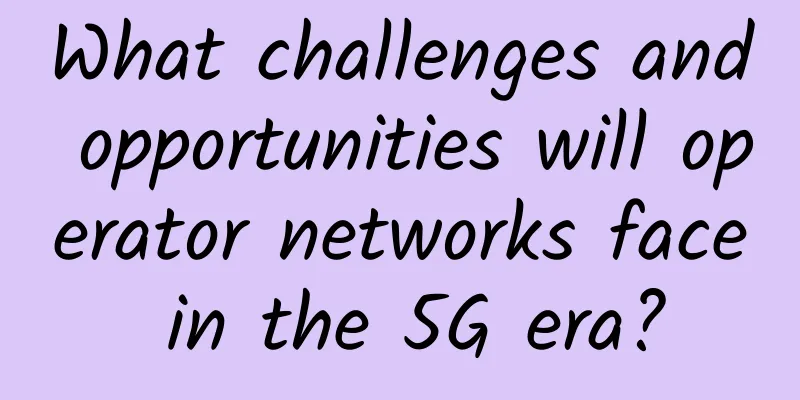What challenges and opportunities will operator networks face in the 5G era?

|
With the official commercial use of 5G in China, it has been more than a year. During this period, with the continuous development of industry trends such as the Internet and mobility, new challenges and opportunities have been brought to the business of traditional service providers. At present, service providers are in a critical period of business transformation, and this transformation originated from the new market demand for business, which will eventually be reflected in the construction and upgrade of service providers' infrastructure. The introduction of technologies such as cloud computing, big data, and artificial intelligence is providing technical support for operators to cope with the challenges brought by the 5G market.
Challenges facing carrier networks The 5G era has brought unprecedented impacts to operators' networks. With the commercialization of 5G, the 5G architecture will connect hundreds of millions of smart devices, and network traffic will increase by more than ten times. The architecture needs to demonstrate enhanced and higher levels of flexibility, agility, and automation, which largely relies on network function virtualization (NFV) and software-defined network (SDN) infrastructure to achieve the elasticity required for on-demand expansion and deployment of network functions and support a variety of new mobile applications. In order to meet the requirements of low latency and high concurrency of 5G terminals, 5G networks adopt a more intensive micro-base station deployment method, and each base station is actually equivalent to a small or micro data center, with computing, storage, network and other capabilities. The increasing number of distributed data centers has undoubtedly increased the complexity of the management and maintenance of the entire network system, and the management costs required are weakening their profitability. In order to adapt to the diversified needs of future business services, operators will increasingly use AI in automated business processes, and will also begin to introduce related technologies such as microservices and containers at the business application level to enable more detailed orchestration of business applications. The application of these new technologies actually puts higher demands on a series of links in traditional data center networks, from architecture to management and maintenance. For example, due to the integration of technologies such as network slicing, microservices, and containers, east-west traffic has increased dramatically, and the original network architecture and solutions can no longer meet the performance requirements of the entire network. At the same time, the cloudification transformation of data centers and the coexistence of the two 5G technology paths, NSA and SA, have brought considerable challenges to operators' subsequent network maintenance. Therefore, a more intelligent and automated network deployment and operation and maintenance management method will surely become the first choice for future operators. In addition, the massive connection feature of 5G also brings new security risks. For example, a large number of IoT devices connected to the 5G network will bring great risks and challenges to security. Security boundaries will become more blurred in the 5G era, the number of intrusion paths will increase greatly, and there will be more vulnerabilities exposed to hackers. 5G creates huge potential for the operator market At present, although 5G construction has temporarily slowed down operators' revenue and increased costs, and the current market demand and user willingness to pay are relatively low, and concerns about network security and other factors will delay the rapid implementation of 5G, we should also see the new opportunities brought by the supply side, such as the innovation space brought about by the transformation of 5G network construction and operation and maintenance models, and the market value created by network slicing for operators' differentiated operations. These are foreseeable realistic opportunities. In addition, the continuous development of 5G technology has also created unlimited potential for the Internet of Things (IoT). For example, the dependence of industrial Internet, smart medical care, campus networks, and small and medium-sized enterprises on IoT solutions is gradually increasing. It is expected that global telecom operators will deploy more and more NB-IoT and LTE-Cat M IoT networks. Therefore, under the catalysis of 5G, the global market for IoT projects and solutions will continue to expand. At the same time, operator networks need to reconsider and adjust security strategies across the entire network. To solve 5G security issues, both technology and management must be strengthened. The improvement of capabilities such as security services will also bring new business forms and business models to the operator market. In the future, operators themselves will also have four core capabilities: the ability to maintain network resource advantages, the ability to innovate services to meet new business needs, the ability to lead and develop new business scenarios, and the ability to establish equal and close partnerships with the ecosystem. The cornerstone of operators' 5G bearer networks Although 5G has indeed brought many challenges to the operators' business, forcing operators to transform and upgrade their existing IT systems. Fortunately, in terms of ensuring that the operator network carries 5G services, there are relatively mature vendor solutions available in the market, and the most outstanding one is Juniper Networks. Why do you say that? Because Juniper Networks has mature hardware, 5G architecture upgrade solutions, and security, and can provide operators with the building blocks required for 5G networks from multiple different angles. The most important thing is that its products and solutions are completely independently developed and continuously evolved. For example, in terms of SD-WAN networking for operator services, solutions from metropolitan area networks, edge to core networks for 5G transformation, and the widely deployed Contrail software product portfolio, etc., it can be said that in terms of operator business support, it is completely Juniper Networks' traditional advantage project, and both technical maturity and system compatibility are excellent. The scalable platform provided by Juniper Networks' SD-WAN solution can help service providers increase revenue while providing users with intent-driven business results at a lower cost. Scalability and policy control have greatly improved the business agility of the operator's network. Juniper Networks has always emphasized the security and compatibility of SD-WAN, and believes that secure, hybrid SD-WAN is the future of wide-area communications. Juniper Networks continues to transform branches and modern WANs by providing comprehensive SD-WAN solutions with integrated network services, while also providing comprehensive security strategies and solutions to ensure that operators obtain a sustainable security platform. More importantly, not only security, but also rapid deployment and maintainability have become an important part of 5G service delivery. Service providers must consider properly planning the subsequent deployment and maintenance of the system during the continuous evolution of 5G. Juniper Networks can achieve rapid, agile, and automated deployment of SD-WAN and SD-Branch through fully automatic connections, thereby ensuring that operator services can be easily deployed and centrally orchestrated. Juniper Networks' new ACX access and aggregation platform provides the IPsec transmission required in the 5G era, ensuring real-time and bandwidth requirements. Juniper Networks also uses new chips to design its MX series 5G universal routing platform, which will help operators transform their network infrastructure. To make these enhanced infrastructures more complete, the Contrail software portfolio allows operators to simplify network design, implementation and operation through an integrated software portfolio, from managing individual devices to achieving overall automated operations. In short, in order to better adapt to the business development needs of the 5G era, operators must start from the infrastructure support level and transform the existing network structure and framework to adapt to the distributed and core network needs of the future 5G era. In these aspects, Juniper's product and technology advantages accumulated from its long-term deep cultivation in the operator market are very obvious. By improving the flexibility and ease of management of operator networks, and providing secure and reliable data center network solutions, it provides solid technical support for operators to carry 5G services, thereby effectively supporting operators to better grasp future development opportunities in the 5G era. 5G has arrived, and it is time for transformation. In the future, new business forms and new models, new technologies and new demands will simultaneously attack operators, and operators will also meet challenges and seek opportunities in the continuous transformation and adjustment. |
<<: 5G is coming. How can 2G/3G be smoothly decommissioned?
>>: China's 5G user numbers exceed 100 million, three major operators announce June results
Recommend
HostYun Los Angeles, USA, CN2 GIA line AMD series VPS monthly payment starts from 16 yuan, native IP
HostYun recently launched a VPS with AMD 5950X+Sa...
What is missing from licensing 5G for commercial use?
On February 20, South Korea announced the officia...
Huawei's Lu Yiquan: Premium Private Line 2.0 creates ubiquitous quality connections
At the "Optical Connection of Everything, In...
Slow Internet speed, poor WIFI signal? This is how you can operate your router
Perhaps when you are working, you will encounter ...
The United States has another big move for 5G: agreeing to merge two major operators
The Trump administration has tried every possible...
Five driving forces and four challenges for 5G development
At the end of June, MWC19 Shanghai was once again...
Ministry of Industry and Information Technology: The Chinese government is resolute in protecting personal information
[[384493]] Yesterday morning, the State Council I...
Data Cabling: Seven Tips for Office Renovations and Relocations
Technological advancements have helped businesses...
Data Center and IT Facilities Priorities
Today, businesses undergoing digital transformati...
Top 10 Internet Acquisitions of 2020
Even in the global economic downturn, the network...
10 SD-WAN projects to watch
[[323303]] GlobalConnect | Versa Networks GlobalC...
Basic introduction and installation verification of the open source API gateway Kong
Today I am going to introduce the open source API...
Why is China's 5G commercialization going astray?
"The 5G race is a race that the United State...
5G and AI Use Cases - How 5G Helps Implement Artificial Intelligence
Michael Baxter says 5G will unlock the potential ...
How the Network Supports Zero Trust
[[354213]] Building a zero-trust architecture typ...









